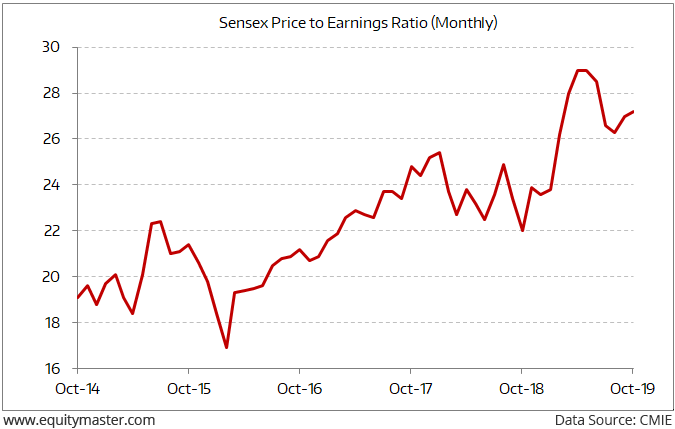India's Third Giant Leap
This Could be One of the Biggest Opportunities for Investors
- Home
- Todays Market
- Indian Stock Market News November 7, 2019
Sensex Opens Higher; Realty Stocks Lead Thu, 7 Nov 09:30 am
Asian share markets are mixed today. The Shanghai Composite is flat while the Hang Seng is down 0.3%. The Nikkei 225 is trading flat. US stocks ended mixed yesterday, with the Dow little changed, as Wall Street digested decreased US labor productivity in the third quarter and a speech of Chicago Federal Reserve President Charles Evans.
Back home, India share markets opened higher. The BSE Sensex is trading up by 137 points while the NSE Nifty is trading up by 32 points. The BSE Mid Cap index and BSE Small Cap index opened up by 0.6% and 0.5% respectively.
Sectoral indices have opened the day on a mixed note with realty stocks and consumer durables stocks witnessing maximum buying interest. Automobiles stocks and metal stocks are trading in red.
The rupee is currently trading at 71.10 against the US$.
Speaking of the Sensex touching record high, how expensive is the Sensex at current levels? What has the trend been in recent years?
It would be interesting to see how the valuation of the index has moved over the last five years.
The chart below maps the price to earnings ratio of the Sensex from October 2014 to now.
How Pricey Is the Sensex Now?
Here's what Ankit Shah wrote about this in a recent edition of The 5 Minute WrapUp...
- It is worth noting that the Sensex has gained 44% over the last five years, compounding at an annual rate of 7.6% (excluding dividends).
Not quite impressive.
During the same period, the Sensex price to earnings ratio has mostly been in a rising trend, except some intermittent declines.
Between October 2014 and now, the gain in the Sensex price to earnings ratio is 42%. That means that the gains in the index have mostly come from expansion in the valuation multiple, and just meagerly from increases in earnings.
So, before taking the current market bullishness for granted, do weigh in the fact that the Sensex is quite expensively priced.
Also, amid the mood swings of Mr. Market witnessed lately, Tanushree Banerjee in the video below talks about the Rebirth of India phenomenon and how 3 specific trends are racing ahead even in these gloomy times.
Tune in to find out more...
In the news from the economy. Fitch Solutions on Wednesday raised India's fiscal deficit forecast to 3.6% of the GDP for this fiscal year, from 3.4% previously, due to weak revenue collections resulting from sluggish economic growth and government's sweeping corporate tax rate cut.
Fitch said it was revising the fiscal deficit forecast as revenue collection is likely to fall far short of the projections in the FY20 Union Budget due to weak goods and services tax (GST) and corporate income tax collections.
The government on September 20, had announced that it would be slashing corporate income taxes for domestic companies to 22% from 30% previously.
This would bring effective corporate tax rate, including all additional levies, to about 25.2%, for companies which are not receiving any incentives or exemptions.
New manufacturing companies formed after October 1, will enjoy a 15% (effective rate of 17%) corporate income tax rate, versus 25% previously.
The move is estimated to result in Rs 1.45 trillion in revenue loss for the government during FY20.
Corporate tax accounts for 28% of total receipts. Therefore, the sharp reduction in tax rates will drag heavily on revenue collection.
Separately, Fitch expects weak private consumption growth to weigh on GST collection and this is already being reflected in the growing shortfall in GST collections thus far in FY20.
Besides, private consumption growth more than halved to 3.1% year-on-year in Q1 of FY20 from 7.2% year-on-year in Q4 of FY19 largely due to the collapse of a dominant Non-Bank Finance Company (NBFC) in the industry, the Infrastructure Leasing & Financial Services Ltd (IL&FS), in September 2018, it added.
Moving on to the news from the pharma sector. As per an article in a leading financial daily, the United States Food and Drug Administration (USFDA) has issued four observations each for Aurobindo Pharma's two units in Hyderabad after inspecting the sites in October.
The USFDA inspected active pharmaceutical ingredients (API) manufacturing facility (Unit V) at Pashamylaram and API manufacturing facility (Unit VIII) at Gaddapotharam in Hyderabad between 21 October 2019 and 28 October 2019.
Reportedly, these observations are related to procedural improvements and none of the observations are related to data integrity.
The company said it would be responding to USFDA as per the prescribed timelines.
With respect to Unit IV, formulation manufacturing facility at Pashamylaram, the inspection is in progress, it added.
Notably, the stock has fallen more than 40% in the last one year.
Aurobindo Pharma share price opened the day down by 1.2%.
To know what's moving the Indian stock markets today, check out the most recent share market updates here.
For information on how to pick stocks that have the potential to deliver big returns, download our special report now!
Read the latest Market Commentary



Equitymaster requests your view! Post a comment on "Sensex Opens Higher; Realty Stocks Lead". Click here!
Comments are moderated by Equitymaster, in accordance with the Terms of Use, and may not appear
on this article until they have been reviewed and deemed appropriate for posting.
In the meantime, you may want to share this article with your friends!